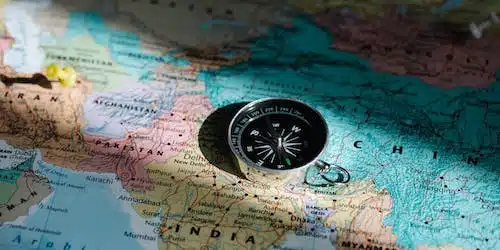Explore the fascinating history of nations lost to time and geopolitical shifts as we delve into the intriguing stories of countries that do not exist anymore. Several countries no longer exist as political entities due to historical, political, and social factors. These countries were created, dissolved, or transformed throughout history, resulting in the creation of successor states and the dissolution of major political entities. In this article, we have listed the updated countries that don’t exist anymore and the factors that led to their dissolution.
Countries That Don’t Exist Anymore
There are several countries that no longer exist as political entities. The geopolitical landscape has witnessed numerous changes throughout history, with countries being created, dissolved, or transformed due to various political, social, and historical factors.
List Of Countries That Don’t Exist Anymore
#1. Abyssinia
Also known as the Ethiopian Empire, Abyssinia was a kingdom in northeast Africa that no longer exists.
#2. Austria-Hungary
Austria-Hungary was a dual monarchy in Central Europe that dissolved after World War I.
#3. Czechoslovakia
Czechoslovakia was a country in Central Europe that emerged after World War I and dissolved in 1993, splitting into the Czech Republic and Slovakia.
#4. Gran Colombia
Gran Colombia was a republic in South America that was established by Simón Bolívar and dissolved in 1831.
#5. Soviet Union
The Soviet Union was a socialist state that existed from 1922 to 1991, encompassing several countries in Europe and Asia.
#6. Yugoslavia
Yugoslavia was a socialist federation in Southeast Europe that dissolved in the 1990s, resulting in the creation of several successor states, including Bosnia and Herzegovina, Croatia, Montenegro, North Macedonia, Serbia, and Slovenia.
#7. Prussia
Prussia was a kingdom and later a state in northeastern Europe. It played a significant role in European history but ceased to exist after World War II when it was dissolved by the Allied powers.
#8. Tibet
Tibet was a region in Central Asia that had a unique political and cultural identity. It lost its de facto independence in 1951 when it was occupied by the People’s Republic of China, resulting in its status as an autonomous region of China.
#9. East Germany
East Germany, officially known as the German Democratic Republic (GDR), was a socialist state that existed from 1949 to 1990. It was formed as a result of the division of Germany after World War II and was reunified with West Germany in 1990.
#10. South Yemen
South Yemen, officially known as the People’s Democratic Republic of Yemen, was a socialist state in the southern part of the Arabian Peninsula. It existed from 1967 to 1990 when it merged with North Yemen to form the present-day Republic of Yemen.
#11. Rhodesia
Rhodesia, also known as Southern Rhodesia, was a self-governing British colony in southern Africa. It unilaterally declared independence from Britain in 1965, but its independence was not internationally recognized. It later became the Republic of Zimbabwe after a period of conflict and negotiations.
#12. East Pakistan
East Pakistan was a region that later became the independent country of Bangladesh. It was geographically separated from West Pakistan and experienced political and cultural tensions, leading to the Bangladesh Liberation War in 1971 and the establishment of Bangladesh as a separate nation.
#13. North Vietnam and South Vietnam
Vietnam was divided into North Vietnam and South Vietnam during the Vietnam War. North Vietnam was a communist state, while South Vietnam was a non-communist state supported by the United States. The division ended in 1976 when North Vietnam reunified the country under communist rule.
#14. East Timor
East Timor, officially known as Timor-Leste, was a former colony of Portugal. It declared independence in 1975 but was invaded and occupied by Indonesia. After a period of conflict, East Timor gained full independence in 2002.
#15. Tanganyika
Tanganyika was a sovereign state in East Africa that existed from 1961 to 1964. It gained independence from British colonial rule and later merged with Zanzibar to form the United Republic of Tanzania.
Factors That Contributed To The Dissolution Of Countries That Don’t Exist Anymore.
These factors played a role:
#1. Political Conflicts and Wars
Many countries on the list experienced political conflicts or wars that led to their dissolution or transformation. Examples include the American Civil War, the Vietnam War, and the conflicts that led to the breakup of Yugoslavia.
#2. Colonialism and Decolonization
Several countries were former colonies that gained independence and later underwent significant changes. Examples include East Timor, which was colonized by Portugal and later gained independence from Indonesia, and Rhodesia, which was a British colony that declared independence but faced international pressure and eventually became Zimbabwe.
#3. Ethnic and Cultural Tensions
Countries with diverse ethnic or cultural groups sometimes face challenges in maintaining unity. Yugoslavia, for example, had different ethnic groups with competing interests, which contributed to its dissolution.
#4. Political Ideologies and Systems
The rise and fall of political ideologies and systems can also lead to the dissolution of countries. The collapse of the Soviet Union resulted in the independence of several countries that were part of the federation.
#5. International Agreements and Treaties
Some countries were formed through international agreements or treaties and dissolved when those agreements were no longer viable. Austria-Hungary, for example, dissolved after World War I due to the Treaty of Trianon.
Social and economic factors can also contribute to the dissolution of countries. Economic disparities, social unrest, and inequality can create tensions that lead to political changes and the reconfiguration of borders.
#7. Internal Divisions and Secession Movements
Internal divisions within a country, often along ethnic, religious, or regional lines, can lead to secessionist movements and the breakup of a country. This was the case with the dissolution of Czechoslovakia, where political and cultural differences between the Czechs and Slovaks resulted in the peaceful separation of the country.
#8. Imperialism and Annexation
Some countries ceased to exist due to the expansionist policies of other nations. For example, Abyssinia (Ethiopian Empire) faced colonisation and eventual annexation by Italy during the late 19th and early 20th centuries.
#9. Shifts in Geopolitical Alliances
Changes in geopolitical alliances can also lead to the dissolution of countries. For instance, the fall of the Soviet Union and the end of the Cold War resulted in the independence of several former Soviet republics as they shifted away from the communist system.
#10. Natural Disasters and Environmental Factors
Natural disasters and environmental challenges can have a significant impact on a country’s stability and existence. For example, countries like Tanganyika faced internal struggles exacerbated by environmental issues such as drought and famine, which contributed to political instability and eventual merging with Zanzibar to form Tanzania.
Effects Of Countries That No Longer Exist
The effects of countries that no longer exist can vary depending on the specific circumstances and context.
#1. Political and Administrative Changes
The dissolution or non-existence of a country often leads to significant political and administrative changes. New countries may emerge, borders may be redrawn, and governance structures may be reconfigured. This can impact the lives of citizens, the functioning of institutions, and the distribution of power.
The dissolution of a country can have profound social and cultural effects. It may result in the displacement of populations, the redefinition of national identities, and changes in cultural practices and traditions. These shifts can lead to both challenges and opportunities for individuals and communities.
#3. Economic Consequences
The dissolution of a country can have economic consequences, both positive and negative. It can disrupt trade relationships, create uncertainty for businesses and investors, and impact the overall economic stability of the region. On the other hand, it can also create opportunities for economic growth and development in newly formed countries.
#4. Shifts in Geopolitical Dynamics
The dissolution or non-existence of a country can lead to shifts in geopolitical dynamics. It can alter the balance of power in a region, create new alliances, and reshape international relations. This can have implications for global politics and influence the dynamics of conflicts and cooperation.
#5. Migration and Refugee Crises
The dissolution of a country can result in significant population movements, including forced displacement and refugee crises. People may flee their homes due to political instability, violence, or economic hardships. This can have humanitarian, social, and economic consequences for both the affected country and the regions where refugees seek shelter.
#6. Loss or Preservation of Cultural Heritage
The non-existence of a country can impact the preservation or loss of cultural heritage. Historical sites, artefacts, and traditions associated with the country may be at risk. Efforts to safeguard cultural heritage become crucial to ensuring the preservation of the country’s identity and history.
#7. Redistribution of Resources
The dissolution of a country can lead to the redistribution of resources, including land, natural resources, and infrastructure. This can have economic implications, as new countries may need to negotiate resource-sharing agreements or establish new systems for resource management.
#8. Challenges to International Recognition and Legitimacy
Countries that no longer exist may face challenges in terms of international recognition and legitimacy. The status of their former territories, sovereignty claims, and representation in international organisations can be subject to dispute and negotiation.
#9. Impact on Regional Stability
The dissolution of a country can have repercussions for regional stability. It can create power vacuums, fuel conflicts, or trigger tensions among neighbouring countries. Regional organisations and neighbouring states may need to navigate the consequences and work towards maintaining stability.
#10. International Relations and Diplomacy
The non-existence of a country can have implications for international relations and diplomacy. It may require the establishment of new diplomatic relationships, the renegotiation of treaties and agreements, and the repositioning of countries within the global community. This can impact regional dynamics and geopolitical balances.
How New Countries Are Formed from the Countries That Don’t Exist Anymore
New countries can be formed through various processes and circumstances, some common ways in which new countries have emerged include
#1. Declaration of Independence
A region or territory may declare independence from an existing country, asserting its sovereignty and establishing itself as a separate nation. This can occur due to political, cultural, or historical factors, as well as aspirations for self-determination. Examples include South Sudan declaring independence from Sudan in 2011.
#2. Decolonization
Former colonies may gain independence from their colonial powers, leading to the formation of new countries. This process often occurs through negotiations, peaceful transitions, or struggles for independence. Many African and Asian countries gained independence from European colonial powers during the mid-20th century.
#3. Dissolution of Empires
The breakup or collapse of empires can result in the formation of new countries. This can happen when regions within an empire seek self-rule or when empires disintegrate due to political, social, or economic factors. Examples include the dissolution of the Austro-Hungarian Empire and the Ottoman Empire after World War I.
#4. Peaceful Separation
In some cases, regions within a country may peacefully separate to form new nations. This can occur through negotiations, referendums, or agreements between the central government and the aspiring region. An example is the peaceful separation of Czechoslovakia into the Czech Republic and Slovakia in 1993.
#5. Armed Conflict and Secession
Armed conflicts or secessionist movements can lead to the formation of new countries. These situations often involve struggles for autonomy or independence by certain regions or ethnic groups within an existing country. Examples include the breakup of Yugoslavia into several independent nations during the 1990s.
#6. Territorial Disputes and Boundary Changes
Territorial disputes between countries can sometimes lead to the creation of new countries. These disputes may arise due to conflicting claims over certain territories or changes in borders. As a result of negotiations or international agreements, new countries can emerge.
#7. Unification Movements
Unification movements can bring together regions or territories that share a common language, culture, or historical background. This can lead to the formation of new countries as separate entities merge into a unified nation. An example is the reunification of East and West Germany in 1990, which resulted in the formation of a single German state.
#8. Referendums and Popular Votes
Some countries hold referendums or popular votes to determine the fate of a region or territory. These votes can lead to the creation of new countries if the majority of the population supports independence or a change in political status. For instance, Montenegro held a referendum in 2006, resulting in its separation from Serbia and the establishment of an independent Montenegro.
#9. International Intervention and Peace Agreements
In certain cases, international intervention or peace agreements can pave the way for the formation of new countries. These interventions may aim to resolve conflicts, protect minority rights, or ensure stability. As part of these agreements, regions may be granted autonomy or independence. An example is the independence of East Timor from Indonesia in 2002, following a period of international intervention and a referendum.
#10. Revolution and Regime Change
Revolutions or major political changes within a country can sometimes lead to the formation of new countries. These events may involve the overthrow of a government or regime, leading to the establishment of a new political entity. For example, the Russian Revolution in 1917 resulted in the collapse of the Russian Empire and the formation of the Soviet Union.
What Are The Oldest Countries?
The oldest countries in the world include Egypt, Iran, Vietnam, Armenia, and North Korea. Egypt is known for its ancient civilization dating back to around 3100 BCE, while Iran has a long history dating back to around 3200 BCE. Vietnam’s history can be traced back to around 2879 BCE, Armenia to around 2492 BCE, and North Korea to around 2333 BCE. These countries have rich cultural and historical legacies that contribute to their status as some of the oldest nations.
What Countries Don’t Exist After WWI?
After World War I, several countries underwent significant changes or ceased to exist. The Austro-Hungarian Empire, the Ottoman Empire, the Russian Empire, the German Empire, and the Kingdom of Serbia are examples of countries that no longer existed in their previous forms. These changes resulted in the formation of new nations, the redrawing of borders, and the establishment of different political systems. The aftermath of World War I reshaped the geopolitical landscape and had a profound impact on the affected regions.
What Is The Newest Country?
The newest internationally recognised country in the world is South Sudan. South Sudan declared independence from Sudan on July 9, 2011, and became the newest member of the United Nations shortly after. South Sudan’s journey as an independent nation has been marked by challenges, including civil war and economic difficulties. It’s worth noting that there are other proposed countries and regions seeking independence, such as New Caledonia and Chuuck, but they have not yet achieved full recognition as independent nations
What Is The Smallest Country In The World?
The smallest country in the world is the Vatican City. With a land area of only 0.19 square miles (0.49 square kilometers), the Vatican City is an independent city-state located in Rome, Italy. It is the spiritual and administrative headquarters of the Roman Catholic Church and has a population of around 800 to 900 people.
Conclusion
The dissolution of countries can be influenced by various historical, political, economic, social, and environmental factors. The dissolution of a country can lead to political, administrative, social, and economic changes, as well as shifts in geopolitical dynamics. New countries can be formed through various processes, such as declaration of independence, decolonization, dissolution of empires, peaceful separation, or armed conflict and secession. Declarations of independence, decolonization, dissolution of empires, peaceful separation, and armed conflicts are common ways new countries emerge from existing ones.
- CHEAPEST COUNTRIES TO VISIT
- EAST AFRICAN COUNTRIES: The Ultimate List
- TOP 10 COUNTRIES THAT WILL PAY YOU TO MOVE THERE






